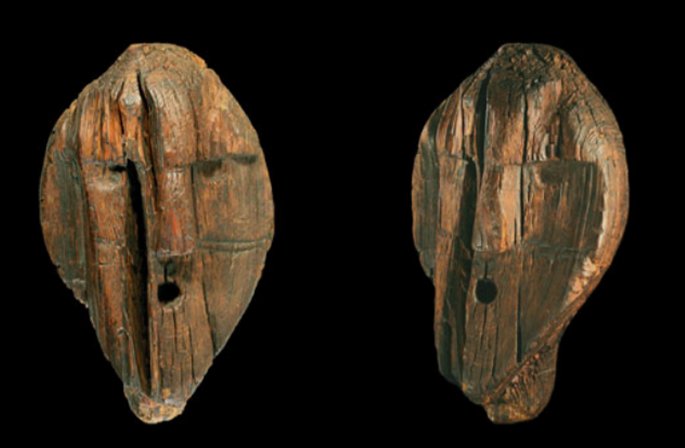
11,600-Year-Old Carvings Recovered From A Siberian Peat Bog May Be First Portrayal Of A Demon.
The statue, which has been named the Shigir Idol, was originally discovered in 1894 by some gold miners. The statue had been preserved in a peat bog, and upon discovery, it was brought to a museum in the Russian city of Yekaterinburg, nearby where it was found. Though the statue was long thought to be at most a couple thousand years old, radiocarbon dating done by a team of researchers revealed that the statue was around 9,900 years old.
The story doesn’t stop there though, as the initial radiocarbon dating of the idol used only a few samples, and a more intensive investigation of the idol’s age (done with Accelerator Mass Spectrometry) found that the idol was around 11,500 years old. For contrast, the great pyramids of Giza are believed to be around 4500 years old. This makes the statue one of the oldest known pieces of monumental art.
This means that the Shigir Idol was probably carved sometime during the Early Holocene era. The Holocene era started around 11,650 years before modern day, occurring after the last major glacial period. The Holocene era saw the beginning of agriculture and the development of more advanced hunting tools like bows and arrows. The glaciers that covered Europe and northern Asia were withdrawing during this period as the climate warmed.
Not only did the researchers involved in the study determine a more accurate timeframe for the idol’s origin, they also determined that the idol was likely carved from one giant log and that the idol contains a previously overlooked face carved into it. The Shigir Idol is covered in various carvings of hands and faces, including a prominent human-shaped head that has its mouth open in an “O” shape. These shapes were probably carved into the statue using ancient chisels and the lower jaws of beavers, which could be sharpened into a convenient tool for cutting out concave surfaces.
Exploration of a similar site only about 50 kilometers away from where the idol was found has revealed many small daggers and possible chisels from the same time period, made out of bone. Elk antlers with animal faces carved into them were also revealed at the site.
Implications For Prehistorical Societies
Thomas Terberger, an archaeologist from Germany’s State Agency for Heritage Service of Lower Saxony, expressed astonishment that the idol had managed to survive for this long. Though while the statue has managed to survive, it has not done so without damage. While the idol originally stood about 5 meters (17 feet) high, some of the sections of the idol were lost throughout the years and now it only stands around 3.5 meters (11.1 feet) high.
Terberger says the idol is evidence that complex artwork emerged around the globe, not just in one area. Furthermore, it implies that complex art was also made by hunter-gatherers and not only by farming societies. Terberger says that archaeologists have to conclude that rituals didn’t “start with farming, but with hunter-gatherers”.
Peter Vang Petersen, an archaeologist from the National Museum of Denmark, wasn’t involved with the study but he says that the art styles of hunter-gatherer societies shifted as the climate warmed and people spread out across Eurasia. The change in art styles may have reflected a changing relationship with the world, as forests began to spread out across the more hospitable landscape.
Says Petersen:
Figurative art in the Paleolithic and naturalistic animals painted in caves and carved in rock all stop at the end of the ice age. From then on, you have very stylized patterns that are hard to interpret. They’re still hunters, but they had another view of the world.
Meanings And Depictions
As for what the symbols and carvings on the Shigir Idol depicted, there’s a substantial amount of debate about the subject. Researchers have compared the Shigir Idol to other pieces of art from around the same period, and even to examples of art from more recent populations. The statue appears to share the most details with finds drawn from a site near Göbekli, some 2500 kilometers away from Yekaterinburg. At Göbekli, hunter-gatherer tribes had carved animals into stone pillars more than 1.5 meters (5 feet) high in a very similar fashion. When compared to these examples and the totem poles of Native American tribes found in the United States’ Pacific Northwest, it’s possible that the Shigir Idol was created to honor certain gods or ancestral spirits.
Mikhail Zhilin, from the Russian Academy of Sciences, was co-author on the study and states that the idol may have functioned as a warning symbol, advising people to keep out of dangerous areas. Zhilin thinks it may depict local demons or spirits of the forest.
Excavations around the Yekaterinburg region have revealed substantial evidence that carving wood was a common practice during the time period the idol was created in. Archaeological teams have found many woodworking tools, stone adzes, and logs prepared with an adze. Zhilin and Terberger think that because wood is unlikely to survive as long as stone, our perception of prehistory may be skewed by the many stone carvings we have found. Terberger expects that there were once many more wooden idols or statues like the Shigir Idol, but that almost all of them simply didn’t survive.
The dating of the Shigir Idol was not the only major event in the field of archaeology to happen this week. Archeologists in Sweden recently uncovered the remains of a massacre which happened over 1500 years ago, when the denizens of a small coastal village were killed during a raid on their village. Meanwhile, in Peru, a team of archaeologists stumbled upon evidence detailing the single largest occurrence of the mass sacrifice of children in the Americas, and possibly in the world.













